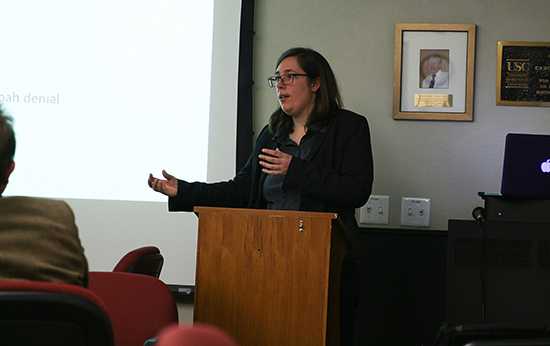Teaching Fellow Alina Bothe Discusses Testimony as “Virtual In-Between of Memory”
Educators, students, scholars and general users of the Visual History Archive all tell the same story: After watching a genocide survivor or witness’s testimony, they feel like they’ve really “met” the person onscreen.
This is the phenomenon that USC Shoah Foundation Center for Advanced Genocide Research 2015-16 Teaching Fellow Alina Bothe set out to study for her PhD thesis at Freie Universität Berlin, and it is what she discussed in a lecture at USC on Tuesday, March 1.

Bothe began her talk by pointing out that the Visual History Archive was always intended to be digital, even when the testimonies were being recorded on analog tapes and none were viewable online yet. In fact, the idea of a digital archive of testimony was so ahead of its time that when journalists first reported on “Steven Spielberg’s Shoah project” in 1994 they couldn’t even visualize what it would look like.
Now that the 53,000 testimonies are indeed accessible in the completely digital Visual History Archive and over 11,000 full testimonies and clips are available to anyone on USC Shoah Foundation’s YouTube channel, USC Shoah Foundation is a fascinating and unique example of a space that is neither completely virtual nor completely analog. Bothe coined it “the virtual in-between.”
Because testimony walks a line between its virtual medium and the physical experience of two people sitting in a room doing an interview, viewers often grapple with feeling like they are part of a dialogue that is close to – but not quite – “real.” It is a “virtual encounter,” Bothe said.
“[Testimony] is accessible and inaccessible, touchable and intangible,” Bothe said. “You can’t walk into the digital archive but you can use it [physically] on many levels.”
Bothe studied the Institute’s YouTube channel to find out some of the ways in which viewers interact with testimony. She analyzed the top 10 most viewed testimonies on YouTube and read the many comments that people had written in response to the videos, categorizing them as: anti-Semitic, critiquing the interviewer, self-revelation, focusing on the historical content of the video, and offering a perception of the interviewee.
She found that the most anti-Semitic comments were made on the testimony of Abraham Bomba, a survivor of Treblinka who was featured in Claude Lanzmann’s seminal film Shoah. Bothe said most of the commenters seemed to be simply using Bomba’s testimony as a place to make their anti-Semitic and Holocaust-denying remarks.
Comments critiquing the interviewer also appear quite often. These viewers complain that the interviewer is “annoying,” rushing the interviewee, or interrogating him or her. These kinds of critiques are common among researchers, Bothe said, who wish the interview had been conducted differently to better suit their own scholarly needs. Bothe pointed out that the interviewer becomes a stand-in for the viewers, who tend to be frustrated that they themselves did not have the chance to physically interact with the survivor and so they take out their frustration on the interviewer.
“This shows an intense perception of testimony,” Bothe said.
Another example of this intense personal connection to the testimony video is the kind of comment that is addressed directly to the survivor as though the viewer really met him or her. For example, one person commented “Thank you, Paula,” on the testimony of Paula Lebovics. These viewers feel, after watching a testimony, that they know the survivor well enough to speak to him or her directly.
Self-revelatory comments include statements about the viewer’s own family history in relation to the survivor’s story or stories about meeting the survivor in person (which aren’t as common in recent years, unfortunately).
All these comments demonstrate that the bond between the virtual and analog is becoming less clear and is always in flux, Bothe said. The virtual sphere allows communication across time and space, and in the virtual in-between a new production of meaning takes place.